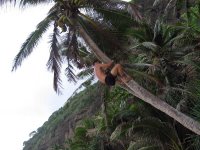One of the features of daily life in Samoa is the extensive use of non-verbal communication. Walk down the street and you'll be nodding your head, raising your eyebrows, grinning, using your eyes and flicking your hand out to quickly wave at a lot of people. It's something you get used to fairly rapidly as it's so immediately obvious.
Some of the non-verbal signals used here are quite backwards to what we're used to in Australia. Meetings are a fine example of a situation where one can be baffled at the conduct of the attendees. I've sat in meetings and watched people clip their toenails, play on their mobile phone, look as if they're falling asleep and otherwise seemingly ignore the speaker. If being spoken to, one may find that the speaker avoids eye contact for the entire conversation. This physical disengagement is a sign of respect. In those meetings, in spite of appearances, everyone is aware of every word that is being spoken.
Other non-verbal signals can inadvertently get you in trouble. If someone senior (in age but particularly in social status) to you is sitting, you should not stand. If you're sitting, never point your feet at someone. I've mentioned the taboos surrounding
whistling already.
The one signal that I've really enjoyed seeing is the hand wave. Sure, it's just waving to someone as they (or you) pass by but here in Samoa it's an art form. I've never come across so many unique, odd and humourous ways of waving to someone. Stay in Samoa for any significant period of time and you'll find yourself developing your own style. I have. Several of my palagi friends have too.
This culturally based non-verbal communication isn't the only kind I've learnt since I've been in Samoa though. Thanks to some very good friends I've been learning Samoan sign language. It's heavily based on Auslan which means I'm learning a language that I can use when I'm back in Australia. For a significant portion of the last ten months, I've spent my Monday evenings learning how to fingerspell, expand my vocabulary and converse fluently. It's been immense fun and my friends have been fantastic teachers. I've now reached a point where I can hold fairly involved conversations with my deaf friends without having to ask for the definition of a sign too often.
I find the linguistic characteristics of sign languages fascinating. At the moment I'm learning classifiers, which are a fundamental part of many languages (such as Japanese and Samoan), but particularly important in sign languages. What is most fascinating for me is the spatial grammar that is employed. Meaning is frequently conveyed by a combination of the hands, the facial expression and the body posture in the same moment. Multiplicity of meaning can be derived from changes to just one or all of these information "channels". As an example, I can use a hand sign in reference to myself, then use that same sign but change my facial expression to turn it into a question to the recipient.
There's a wealth of material online about sign languages and Auslan in particular. I'd recommend looking at Wikipedia's entries on
sign language and
Auslan as a good introduction. The online resource I've benefitted from the most though would have to be the
Auslan Signbank. It's an online dictionary of signs (free registration required). You search for the keyword you're interested in and if it's there, you'll see a small video of the sign and relevant definition(s). It's a great idea very well executed.
My classes will continue up until about one or two weeks before I head back to Australia. I do want to keep learning after I leave though. Thankfully, the
Deaf Education Network runs a variety of courses in NSW on a regular basis. Organisations in other states have similar offerings.
Thanks to friends here I already have a couple of deaf Samoan-Australians to call upon once I'm back in Sydney. I'm excited as it'll be a great way for me to continue to improve my sign language but also continue my relationship with Samoa and Samoan culture. In short, it'll be a lot of fun!
 The second outrigger canoe paddling regatta of the season was held yesterday. A bunch of us have been paddling for a while now but never really in races. The regatta (like the first of the season a few weeks ago) gave us a great chance to get some experience.
The second outrigger canoe paddling regatta of the season was held yesterday. A bunch of us have been paddling for a while now but never really in races. The regatta (like the first of the season a few weeks ago) gave us a great chance to get some experience. The sun never really came out all day so the temperature was quite mild making for perfect conditions for paddling. At the conclusion of the day however, whilst we were sitting back with a couple of beers, the sun came out from behind the clouds and put on one of the best sunsets I've seen in Samoa.
The sun never really came out all day so the temperature was quite mild making for perfect conditions for paddling. At the conclusion of the day however, whilst we were sitting back with a couple of beers, the sun came out from behind the clouds and put on one of the best sunsets I've seen in Samoa.














